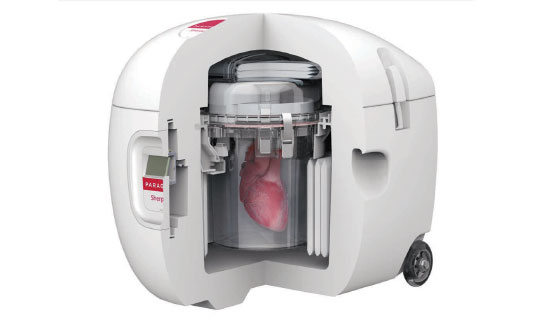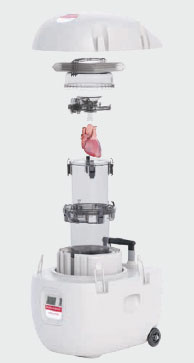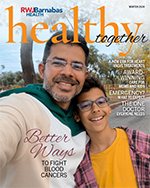
A groundbreaking organ preservation and transport system promises better outcomes for patients on the heart transplant waitlist.
After a careful evaluation finds that someone with end-stage heart failure is a candidate for heart transplant, the person is placed on the transplant waitlist. But the availability of donor hearts continues to be a challenge for patients awaiting heart transplants nationwide, as the number of people on the waitlist continues to increase. Policy changes in the U.S. organ allocation system have also led to transplant teams needing to travel farther geographically to obtain suitable donor hearts.

Once a donor heart is matched to the wait-listed patient, it needs to be transported to the recipient’s hospital. The period between the heart’s removal from the donor to its implantation in the recipient patient is called ischemic time.
In the past, replacing—or in some cases, repairing—defective valves required open heart surgery, a well-established, highly reliable procedure with low complication rates. In recent years, however, increasing numbers of heart patients have benefited from minimally invasive heart procedures that don’t require open heart surgery.
“Preserving the quality of the donor heart during its transfer from the hospital of the donor to that of the recipient has a significant impact on transplant outcomes,” says Deepa Iyer, MD, Advanced Heart Failure, Ventricular Assist Device and Transplant Cardiologist, and Program Director of the Heart Transplant Program at Robert Wood Johnson University Hospital (RWJUH) in New Brunswick. “The longer the ischemic time, traditionally the greater the risk of complications, particularly if ischemic time exceeds four hours.”
Now a groundbreaking organ preservation and transport system called SherpaPak being used at RWJUH promises to address many of these challenges.
Curtailing Complications
 Donor hearts conventionally were placed in an isolation bag containing an approved preservative solution, which in turn was placed in second and third isolation bags and transported in commercial-grade coolers filled with slush ice. “Transporting in slushice-filled coolers potentially leaves the organ vulnerable to injury due to freezing, called thermal injury,” Dr. Iyer says.
Donor hearts conventionally were placed in an isolation bag containing an approved preservative solution, which in turn was placed in second and third isolation bags and transported in commercial-grade coolers filled with slush ice. “Transporting in slushice-filled coolers potentially leaves the organ vulnerable to injury due to freezing, called thermal injury,” Dr. Iyer says.
The FDA-approved SherpaPak system instead suspends the donor heart in special pressure-controlled canisters to cool the heart evenly using phase change cooling technology. The canisters are then placed in a rigid outer box with a protective polystyrene material that maintains the internal temperature for over 40 hours.
“SherpaPak uses innovative technology to keep the donor heart between 4 and 8 degrees Celsius during transport,” says Dr. Iyer. “This prevents thermal injury and decreases the incidence of primary graft dysfunction [PGD], a serious complication.”
PGD is a condition in which the transplanted heart fails and is unable to pump enough blood to meet the body’s needs. It usually occurs less than 24 hours after transplant surgery.
Thermal injury during transport increases the risk of PGD, as does longer ischemic time in donor hearts transported in conventional ice coolers. While early use of special pumps called extracorporeal membrane oxygenation (ECMO) to support the heart and lungs has improved survival in transplant recipients post-PGD, the complication remains the leading cause of mortality early after heart transplantation.
“SherpaPak not only prevents thermal injury but also measures and displays the temperature, ischemic time and location of the donor heart in real time using Bluetooth technology,” Dr. Iyer says. “The procuring surgical team members, along with the transplant surgeons, OR team, transplant cardiologists and transplant coordinators, have access to that information. We can actually see where the heart is during transit on an app.”
Excellent Outcomes
Some transplant centers report using SherpaPak and going over the current recommended ischemic time of four hours and having good outcomes. “This is huge if we can go farther geographically and decrease waitlist time for our patients,” says Dr. Iyer.
RWJUH is the first and only transplant center in New Jersey to use the advanced SherpaPak technology, with funding made possible through the generosity of donors to the RWJ University Hospital Foundation, including the RWJUH Auxiliary. Appreciation extends toward the foundation from both patients and the transplant team.
“The journey from being diagnosed with advanced heart failure to receiving a heart transplant is not easy,” Dr. Iyer says. “My team and I are in awe of the courage and tenacity shown by our patients and their families. It is a precious moment when we inform our patients that we have found the ideal heart for them. It is exhilarating to watch them recover and progress with their new hearts and get a new lease on life. Our Advanced Heart Failure, Ventricular Assist Device and Transplant Program at RWJUH will continue to use innovative therapies and technologies to improve our patients’ experiences and outcomes.”
Expert Care For Advanced Heart Disease
The Advanced Heart Failure, Ventricular Assist Device (VAD) and Transplant Program at Robert Wood Johnson University Hospital (RWJUH) offers the full spectrum of care for end-stage heart failure patients, including durable left VADs, access to clinical trials and Medicare-certified heart transplant services. The Joint Commission has awarded RWJUH a Gold Seal Certification as well as an Advanced Certification in VAD Implantation. RWJUH has dedicated a multidisciplinary team of physicians, nurse practitioners, nurse coordinators, pharmacists, a social worker and a nutritionist solely for its Advanced Heart Failure, VAD and Transplant Program.
Learn more about heart transplants at RWJBarnabas Health or request an appointment.
 View full issues of Healthy Together magazine by New Jersey region:
View full issues of Healthy Together magazine by New Jersey region: